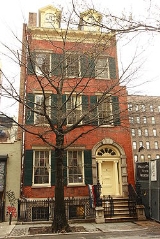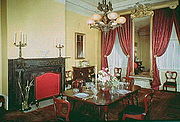
Merchant's House Museum
Encyclopedia
The Merchant's House Museum, known formerly as the Old Merchant's House and as the Seabury Tredwell House, is the only nineteenth-century family home in New York City
preserved intact — both inside and out. Built "on spec" in 1832 by Joseph Brewster, a hatter by trade, it is located at 29 East Fourth Street, between Lafayette Street
and the Bowery in Manhattan
. It became a museum in 1936, founded by George Chapman, a cousin of the family who once lived there.
The house was declared a National Historic Landmark
in 1965. The building underwent a major restoration in 1971 by architect Joseph Roberto and interior designer Carolyn Roberto.
. Its facade is reminiscent of earlier Federal-style homes, but the interior, especially the formal double parlors, represent New York's finest example of Greek revival architecture. The interior also contains the Tredwell family's original furnishings, including pieces from prominent New York cabinetmakers, like Duncan Phyfe
and Joseph Meeks
.
Considered one of the finest surviving Greek Revival rowhouses in America, the house is a miraculous survivor of old New York. The house is important for its outstanding collection of original furnishings, decorative objects, magnificently preserved 19th century clothing and other personal effects of the Tredwell family. Stepping through the front portal is stepping into a time when New York City was becoming the most important seaport in North America and the house reflects these fortunate circumstances.
Several doors east of the museum at 37 East 4th Street is the Samuel Tredwell Skidmore House, a Greek Revival
house built for a cousin of Seabury Tredwell. That building is also a New York City Landmark (designated 1970), but is in disrepair and in need of restoration.
Seabury died in 1865 and the remaining family lived at the home into old age. Gertrude, the youngest member of the immediate family, lived here alone for 24 years after the death of her sister Julia in 1909. As she grew older and more eccentric she became obsessed with holding on to the elegant home in a neighborhood that had become, by the early 20th century, a run-down, semi-industrial, and disreputable part of town. Burdened with severe financial hardship in her last years, she somehow managed to keep the beautiful home in nearly original condition, long after all the neighboring private homes had been demolished or converted into rooming houses, tenements, or commercial structures.
After her death, a distant cousin, George Chapman, purchased the building, saving it from foreclosure and demolition. In 1936, after needed repair and renovation, the house opened as a museum and has remained such ever since. The Merchant’s House Museum remains a unique time capsule of the lives of a typical affluent New York merchant family of the 19th Century complete with the original possessions of the family.
In 1991, in a joint effort with the Greenwich Village Society for Historic Preservation
, the Merchant’s House Museum launched the educational program, "Greenwich Village: History and Historic Preservation". The program was designed to teach students local history, architectural vocabulary, and the fundamentals of historic preservation. The program ran through the end of the 1990s at the museum, but eventually shifted its focus to the West Village, where it continues to reach out to students in the five boroughs.

and historic importance, the Merchant's House has been recognized by the following landmark designations:
New York City
New York is the most populous city in the United States and the center of the New York Metropolitan Area, one of the most populous metropolitan areas in the world. New York exerts a significant impact upon global commerce, finance, media, art, fashion, research, technology, education, and...
preserved intact — both inside and out. Built "on spec" in 1832 by Joseph Brewster, a hatter by trade, it is located at 29 East Fourth Street, between Lafayette Street
Lafayette Street (Manhattan)
Lafayette Street is a major north-south street in New York City's Lower Manhattan, which runs roughly parallel to Broadway to the west. Originally, the part of the street below Houston Street was called Elm Place....
and the Bowery in Manhattan
Manhattan
Manhattan is the oldest and the most densely populated of the five boroughs of New York City. Located primarily on the island of Manhattan at the mouth of the Hudson River, the boundaries of the borough are identical to those of New York County, an original county of the state of New York...
. It became a museum in 1936, founded by George Chapman, a cousin of the family who once lived there.
History
Brewster sold the house to Seabury Tredwell, a wealthy New York merchant, for $18,000. Tredwell's daughter, Gertrude, was born in the house in 1840, and lived there until her death in an upstairs bedroom in 1933. Three years later, the perfectly preserved home opened to the public as a museum.The house was declared a National Historic Landmark
National Historic Landmark
A National Historic Landmark is a building, site, structure, object, or district, that is officially recognized by the United States government for its historical significance...
in 1965. The building underwent a major restoration in 1971 by architect Joseph Roberto and interior designer Carolyn Roberto.
Exterior and interior
The building has been attributed to architect Menard LafeverMinard Lafever
Minard Lafever was an influential American architect of churches and houses in the United States in the early nineteenth century.-Life and career:...
. Its facade is reminiscent of earlier Federal-style homes, but the interior, especially the formal double parlors, represent New York's finest example of Greek revival architecture. The interior also contains the Tredwell family's original furnishings, including pieces from prominent New York cabinetmakers, like Duncan Phyfe
Duncan Phyfe
Duncan Phyfe was one of nineteenth-century America’s leading furniture makers.Born Duncan Fife near Loch Fannich, Scotland, he emigrated to Albany, New York, at age 16 and served as a cabinetmaker’s apprentice...
and Joseph Meeks
Joseph Meeks
Joseph Meeks was a furniture maker in New York who founded what would become a large firm that produced good quality furniture from 1797 to 1869.-References:...
.
Considered one of the finest surviving Greek Revival rowhouses in America, the house is a miraculous survivor of old New York. The house is important for its outstanding collection of original furnishings, decorative objects, magnificently preserved 19th century clothing and other personal effects of the Tredwell family. Stepping through the front portal is stepping into a time when New York City was becoming the most important seaport in North America and the house reflects these fortunate circumstances.
Several doors east of the museum at 37 East 4th Street is the Samuel Tredwell Skidmore House, a Greek Revival
Greek Revival architecture
The Greek Revival was an architectural movement of the late 18th and early 19th centuries, predominantly in Northern Europe and the United States. A product of Hellenism, it may be looked upon as the last phase in the development of Neoclassical architecture...
house built for a cousin of Seabury Tredwell. That building is also a New York City Landmark (designated 1970), but is in disrepair and in need of restoration.
The family
Gertrude and her seven siblings, two brothers and five sisters, all lived here together with their parents, four servants, and an ever-changing assortment of nieces, nephews, cousins, aunts and other relatives. Only two daughters and one son ever married, which was unusual for that era and for an affluent family with social position.Seabury died in 1865 and the remaining family lived at the home into old age. Gertrude, the youngest member of the immediate family, lived here alone for 24 years after the death of her sister Julia in 1909. As she grew older and more eccentric she became obsessed with holding on to the elegant home in a neighborhood that had become, by the early 20th century, a run-down, semi-industrial, and disreputable part of town. Burdened with severe financial hardship in her last years, she somehow managed to keep the beautiful home in nearly original condition, long after all the neighboring private homes had been demolished or converted into rooming houses, tenements, or commercial structures.
After her death, a distant cousin, George Chapman, purchased the building, saving it from foreclosure and demolition. In 1936, after needed repair and renovation, the house opened as a museum and has remained such ever since. The Merchant’s House Museum remains a unique time capsule of the lives of a typical affluent New York merchant family of the 19th Century complete with the original possessions of the family.
The museum
In addition to its magnificent period rooms, the museum presents many performances, presentations, lectures, exhibits and special events throughout the year. Ongoing research and state-of-the-art documentation and conservation techniques assure that more is constantly being learned about the house, its furnishings and outstanding textile collections, and “what life was really like” for a 19th century New York family.In 1991, in a joint effort with the Greenwich Village Society for Historic Preservation
Greenwich Village Society for Historic Preservation
The Greenwich Village Society for Historic Preservation is a non-profit organization that seeks to preserve the architectural heritage and cultural history of several neighborhoods of New York City: Greenwich Village, the East Village, the Far West Village, the South Village, Gansevoort Market,...
, the Merchant’s House Museum launched the educational program, "Greenwich Village: History and Historic Preservation". The program was designed to teach students local history, architectural vocabulary, and the fundamentals of historic preservation. The program ran through the end of the 1990s at the museum, but eventually shifted its focus to the West Village, where it continues to reach out to students in the five boroughs.

Landmark designations
Due to its architecturalArchitecture
Architecture is both the process and product of planning, designing and construction. Architectural works, in the material form of buildings, are often perceived as cultural and political symbols and as works of art...
and historic importance, the Merchant's House has been recognized by the following landmark designations:
- 1936 - Documented by the Historic American Buildings SurveyHistoric American Buildings SurveyThe Historic American Buildings Survey , Historic American Engineering Record , and Historic American Landscapes Survey are programs of the National Park Service established for the purpose of documenting historic places. Records consists of measured drawings, archival photographs, and written...
- 1965 - Designated by the Landmarks Preservation CommissionNew York City Landmarks Preservation CommissionThe New York City Landmarks Preservation Commission is the New York City agency charged with administering the city's Landmarks Preservation Law. The Commission was created in April 1965 by Mayor Robert F. Wagner following the destruction of Pennsylvania Station the previous year to make way for...
as one of the first 20 New York City landmarks - 1965 - Designated as a National Historic LandmarkNational Historic LandmarkA National Historic Landmark is a building, site, structure, object, or district, that is officially recognized by the United States government for its historical significance...
and part of the National Historic Trust in New York - 1966 - Listed on the National Register of Historic Places
- 1981 - Designated as a New York City interior landmark
External links
- Merchant's House Museum Official website

